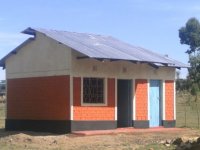|
Nutrition and HealthThe bottom line is than most of these children would go hungry if it were not for the food they receive from the school. Here is a picture of the old kitchen and the new kitchen built by Aid2Africa.
Kenya’s Human Development Index is 0.521, ranking the country 148th out of 177 countries according to the World Heath Organization. Progress in Kenya is slow and uncertain with only education registering significant progress. Health status and indicatorsKey health impact indicators suggest stagnation or decline in the health status.
ChallengesHealth impact indicators suggest wide disparities in health across the country, closely linked to underlying socio-economic, gender and geographical disparities. In rural areas the income level is $1 a day or less. There is a sever lack of access to health facilities and professionals. This results in an inadequate response to manage the disease burden. Roughly 5000 doctors in a population of 38 million people, or 1 doctor for every 7500 people. High burden of untreated communicable diseases. Persistent poverty and low water and sanitation coverage have contributed to sanitation related illnesses like cholera. In the same analogy of teaching a man to fish the best solutions are sustainable solutions. However, the lack of infrastructure and an economic base in rural areas makes this difficult. The school is the foundation for proving sustainable improvements, such as in sanitation, clean water, animal husbandry and agriculture. Our Goals
We want to sponsor annual check-ups for the children including any required treatment. Malaria and Typhoid are endemic in the region. So far this year, 41 children of the Waymarks Education Center were treated for malaria, and 18 for typhoid. All were treated successfully. Mosquito nets can help control Malaria. Where essential, we want to improve living conditions that pose heath risks. The school offers good sanitation and clean water. However, as the number of children increases the school must expand the availability of these resources. Other important needs include Health Education in the school and for the school to have basic First Aid supplies and common medicines. We also would like to provide Dental and Vision care. At present there is no specific funding allocated for these needs. Nutrition and Health Projects
Malaria and Typhoid are endemic in the region. In Fact Malaria is the leading cause of death at 30%. So far this year, 41 children of the Waymarks Education Center were treated for malaria. All were treated successfully. Mosquito nets can help control Malaria. Mosquito nets are about $10 each, $2,000 would enable the school to give every child and staff member a mosquito net.
There are great disparities in health across the country, coupled with a high burden of untreated communicable diseases. There is a sever lack of access to health facilities and professionals. This results in an inadequate response to manage the disease burden. There are roughly 5000 doctors in a population of 38 million people, or 1 doctor for every 7500 people.
The goal here is to provide basic First Aid Kits for the school and the Children’s Homes and keep them stocked for a year.
The bottom line is that most of the children would not eat everyday if not for the meals provided by the school. Right now they get a mug of sweetened maize porridge in the morning at 10 am and a meal later in the day. It resembles a type of stew containing beans cooked with either rice or potatoes. Sometimes they get a banana. We need to improve upon this by adding calories from fresh fruit, vegetables, and most important more protein. At Christmas and Easter we try to have special meals. Our goal is to have the sustainable projects make enough profit to pay for this expense. Until they grow, funding this need is a high priority.
On Christmas and Easter we have traditionally provided special meals for the children. Daily the children mainly have corn porridge. The holiday meals consist of much more, such as meats, chicken and lamb, vegetables, fruits, beverages and treats.
|
Please Help
You May Donate By Credit Card or Paypal
OR
Mail Your Donation to:
28283 Center Ridge Rd.
Westlake, Ohio 44145
See Nutrition and Health Projects
View a Summary
of all Projects
Questions? Suggestions?
Contact Us
Eating Breakfast

Mid-Day Meal

In the School

The Old Kitchen

Cooking Porridge

Dried Maize



